
Pope Urban VIII, born Maffeo Vincenzo Barberini, was head of the Catholic Church and ruler of the Papal States from 6 August 1623 to his death, in July 1644. As pope, he expanded the papal territory by force of arms and advantageous politicking, and was also a prominent patron of the arts and a reformer of Church missions.

Pope Innocent X, born Giovanni Battista Pamphilj, was head of the Catholic Church and ruler of the Papal States from 15 September 1644 to his death, in January 1655.
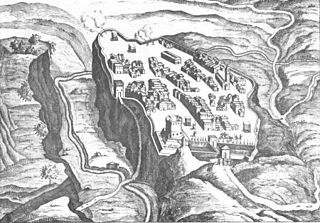
The Wars of Castro were a series of conflicts during the mid-17th century revolving around the ancient city of Castro, which eventually resulted in the city's destruction on 2 September 1649. The conflict was a result of a power struggle between the papacy – represented by members of two deeply entrenched Roman families and their popes, the Barberini and Pope Urban VIII and the Pamphili and Pope Innocent X – and the Farnese dukes of Parma, who controlled Castro and its surrounding territories as the Duchy of Castro.

Bernardino Spada was an Italian Cardinal of the Roman Catholic Church and a patron of the arts whose collection is housed in the Palazzo Spada in Rome.
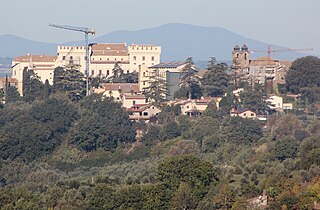
Giove is a comune in the province of Terni.
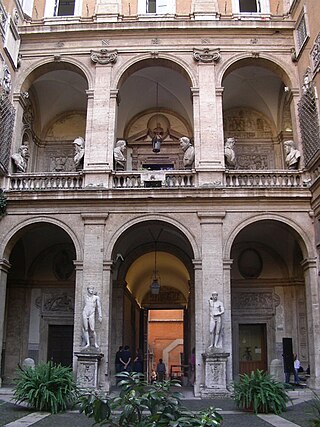
The Palazzo Mattei di Giove is the most prominent among a group of Mattei houses that forms the insula Mattei in Rome, Italy, a block of buildings of many epochs.

The House of Mattei was one of the most powerful noble families of Rome during the Middle Ages and early modern era, holding high positions in the papal curia and government office. The family amassed significant art collections under art enthusiasts such as Ciriaco Mattei.
The Apostolic Chancery was a dicastery of the Roman Curia at the service of the supreme pontiff of the Roman Catholic Church. The principal and presiding official was the chancellor of the Holy Roman Church who was always the cardinal-priest of the Basilica di San Lorenzo in Damaso. The principal function of the office was to collect money to maintain the Papal army and to produce documents and correspondence for the Pope. Pope Pius VII reformed the office when Emperor Napoleon I of France obviated the need for Papal armies. In the early 20th century the office collected money for missionary work. Pope Paul VI abrogated the Cancellaria Apostolica on 27 February 1973. Its obligations were transferred to the Secretariat of State.

The Roman Catholic Suburbicarian Diocese of Palestrina is a Roman Catholic suburbicarian diocese centered on the comune of Palestrina in Italy.

A crown-cardinal was a cardinal protector of a Roman Catholic nation, nominated or funded by a Catholic monarch to serve as their representative within the College of Cardinals and, on occasion, to exercise the right claimed by some monarchs to veto a candidate for election to the papacy. More generally, the term may refer to any cardinal significant as a secular statesman or elevated at the request of a monarch.
Filippo Colonna, 6th Prince of Paliano, Prince of Paliano, was an Italian nobleman, who was the head of the Colonna family of Rome and the hereditary Gran Connestabile at the court of Naples.
Francesco Peparelli was an Italian architect during the 17th century. According to a contemporary historian, Giovanni Baglione, between palaces, castles, churches and convents, Peparelli participated in about seventy construction projects but only about thirty can be attributed to him with certainty.
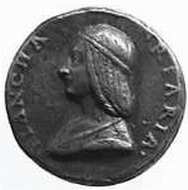
Bianca Riario was an Italian noblewoman and regent, Marchioness of San Secondo by marriage to Troilo I de' Rossi, and regent of the marquisate and county of San Secondo for her son Pier Maria during his minority between 1521 and 1522. She was the eldest child and only daughter of Caterina Sforza by the latter's first husband, Girolamo Riario, a nephew of Pope Sixtus IV.
Ciriaco Mattei was an Italian nobleman of Rome and of the House of Mattei and one of the most prolific art collectors of his time.
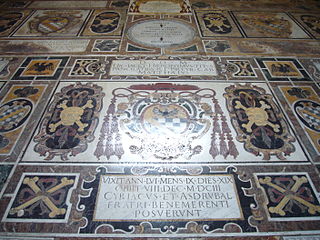
Girolamo Mattei was an Italian Cardinal from the House of Mattei.

The Fontana delle Tartarughe is a fountain of the late Italian Renaissance, located in Piazza Mattei, in the Sant'Angelo district of Rome, Italy. It was built between 1580 and 1588 by the architect Giacomo della Porta and the sculptor Taddeo Landini. The bronze turtles around the upper basin, usually attributed either to Gian Lorenzo Bernini or Andrea Sacchi, were added in either 1658 or 1659 when the fountain was restored.

Fabrizio Spada was an Italian Cardinal of the Roman Catholic Church, and served as Secretary of State under Pope Innocent XII.

Luigi Mattei was an Italian military General and Marquis de Belmonte. During the 17th century he commanded troops loyal to the papal armies of Barberini Pope Urban VIII and Pamphili Pope Innocent X during the Wars of Castro.

Asdrubale Mattei, Duca di Giove, was an Italian nobleman of the House of Mattei, an avid art collector and a patron of Caravaggio.

Cosimo de Torres also Cosmo de Torres and Cosma de Torres (1584–1642) was a Roman Catholic cardinal who served as Cardinal-Priest of Santa Maria in Trastevere (1641–1642), Cardinal-Priest of San Pancrazio (1623–1641), Archbishop of Monreale (1634–1642), Bishop of Perugia (1624–1634), Apostolic Nuncio to Poland (1621–1622), and Titular Archbishop of Hadrianopolis in Haemimonto (1621–1622).














